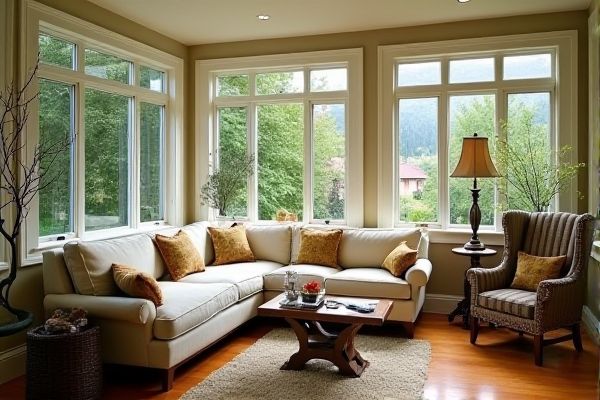
A sunroom typically features lighter construction with screens or single-pane glass, designed mainly for warmer months, whereas a four-season room uses insulated walls, double-pane windows, and HVAC systems for year-round comfort. Discover which option best suits Your lifestyle and home by reading the rest of this article.
Table of Comparison
| Feature | Sunroom | Four Season Room |
|---|---|---|
| Design | Primarily glass walls and roof, maximizing sunlight | Insulated walls, windows, and roofing for year-round use |
| Climate Control | Limited or no heating/cooling, suited for mild seasons | Full heating and cooling systems for comfort in all seasons |
| Insulation | Minimal insulation, often single-pane glass | High-quality insulation with double or triple-pane windows |
| Usage | Seasonal use, mainly spring to autumn | Year-round living space or office |
| Cost | Lower initial cost, less complex construction | Higher cost due to insulation and HVAC requirements |
| Building Codes | May have fewer restrictions | Must meet residential building codes for habitable rooms |
Introduction to Sunrooms and Four Season Rooms
Sunrooms are typically designed with large windows and lightweight construction to provide natural light and ventilation, primarily used during warmer months. Four season rooms feature insulated walls, HVAC systems, and energy-efficient windows, allowing comfortable use year-round regardless of weather conditions. Both enhance living space but differ in climate adaptability and construction specifications.
Key Differences Between Sunrooms and Four Season Rooms
Sunrooms typically feature single-pane glass and limited insulation, making them suitable for mild weather, while four season rooms boast double or triple-pane windows and enhanced insulation for year-round comfort. Four season rooms often include HVAC systems to maintain consistent indoor temperatures, unlike sunrooms that rely on natural ventilation. Understanding these key differences helps you choose the ideal space that matches your climate and lifestyle needs.
Climate and Seasonal Usability Comparison
A sunroom is designed primarily for warm weather use, featuring large windows that maximize sunlight but often lack full insulation, limiting comfort during colder months. In contrast, a four-season room is built with insulated walls, energy-efficient windows, and proper HVAC systems, allowing you to enjoy the space comfortably year-round regardless of climate. Your choice depends on whether you need a bright, breezy retreat for summer or a versatile living area usable throughout all seasons.
Construction Materials and Insulation
Sunrooms typically feature lightweight materials such as aluminum framing and single-pane glass, offering less insulation compared to four-season rooms that use more robust construction materials like wood or vinyl framing combined with double or triple-pane insulated glass. Four-season rooms often incorporate advanced insulation in walls, ceilings, and flooring to maintain comfortable indoor temperatures year-round. Your choice affects energy efficiency, with four-season rooms providing superior thermal performance suited for all climates.
Cost Analysis: Sunroom vs Four Season Room
Sunrooms generally have lower construction and insulation costs due to simpler designs and lighter materials, making them budget-friendly for basic outdoor enjoyment. Four season rooms require enhanced insulation, HVAC systems, and durable materials to maintain comfortable temperatures year-round, increasing both initial expenses and energy costs. Your choice depends on whether you prioritize affordability or year-round usability, as the added investment in a four season room supports consistent comfort and higher property value.
Energy Efficiency and Heating/Cooling Options
Sunrooms often feature large glass panels that can lead to higher heat loss in winter and heat gain in summer, reducing energy efficiency, while four-season rooms are designed with better insulation and HVAC systems that regulate temperature year-round. Your four-season room typically includes double or triple-glazed windows, insulated walls, and heating/cooling options like mini-split systems or radiant floor heating to maintain comfort regardless of season. Energy-efficient four-season rooms minimize utility costs and provide a more reliable indoor climate compared to traditional sunrooms.
Design and Aesthetic Flexibility
Sunrooms typically feature large glass panels and a lightweight frame, offering a bright, airy design that seamlessly connects indoor and outdoor spaces. Four season rooms are built with insulated walls, windows, and HVAC systems, allowing for year-round use while maintaining a more traditional home extension aesthetic. The design of four season rooms provides greater flexibility in interior finishes, enabling customization to match existing home decor and enhance overall comfort.
Permit and Building Regulations
A sunroom typically requires fewer permits and has lighter building regulations since it is often classified as a seasonal or non-heated space. A four-season room, designed for year-round use with insulation and HVAC integration, must comply with stricter building codes and usually requires a full building permit. Understanding your local building department's requirements ensures your project meets all legal standards and avoids costly delays.
Pros and Cons: Sunroom vs Four Season Room
Sunrooms offer abundant natural light and a cost-effective way to enjoy outdoor views, but they typically lack insulation and are less comfortable in extreme weather. Four season rooms provide year-round usability with better insulation, HVAC options, and increased home value, though they come with higher initial costs and more complex construction. Choosing between the two depends on your climate, budget, and how you plan to use the space throughout the year.
Choosing the Right Room for Your Home
Selecting between a sunroom and a four-season room depends on your climate, intended use, and budget. Sunrooms typically feature large windows and are ideal for mild weather, providing a bright, airy space mainly for seasonal enjoyment. Four-season rooms offer insulated walls, heating, and cooling systems, allowing year-round comfort and enhancing home value by extending usable living space regardless of weather conditions.
 homyna.com
homyna.com